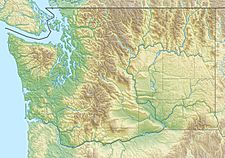Honeycomb Glacier (Washington) facts for kids
Quick facts for kids Honeycomb Glacier |
|
|---|---|
| Type | Mountain glacier |
| Coordinates | 48°04′28″N 121°03′38″W / 48.07444°N 121.06056°W |
| Area | 1.31 sq mi (3.4 km2) |
| Length | 2.48 mi (3.99 km) |
| Terminus | Proglacial Lake/Talus |
| Status | Retreating |
Honeycomb Glacier is a large river of ice located in the Glacier Peak Wilderness in the U.S. state of Washington. It is mostly found within the Mount Baker-Snoqualmie National Forest. A small part of the glacier also reaches into the Wenatchee National Forest.
Honeycomb Glacier is one of the biggest glaciers in the North Cascades mountain range. It is very close to the White River and Suiattle Glaciers. Only a sharp ridge of rock, called an arête, separates them near the Kololo Peaks.
Contents
What is a Glacier?
A glacier is like a very slow-moving river made of ice. It forms when snow piles up over many years and gets squeezed into thick, dense ice. Glaciers are powerful and can slowly shape mountains and valleys as they move.
Where is Honeycomb Glacier Located?
Honeycomb Glacier is found in the beautiful Glacier Peak Wilderness. This wilderness area is part of the Cascade Range in Washington state. Most of the glacier is in the Mount Baker-Snoqualmie National Forest. A smaller part near its top extends into the Wenatchee National Forest.
The glacier is also very close to other large glaciers. These include the White River Glacier and the Suiattle Glacier. They are separated by a narrow, jagged ridge of rock.
How Honeycomb Glacier is Changing
Honeycomb Glacier is one of the largest glaciers in the North Cascades. However, it has been shrinking for a long time. Since around the year 1850, it has gotten much smaller.
The Little Ice Age and Retreat
The period around 1850 is considered the end of the "Little Ice Age." This was a time when many parts of the world were colder than they are today. Since then, Honeycomb Glacier has retreated, or melted back, by about 1.08 mi (1.74 km).
A big part of this retreat happened more recently. Over a quarter of its shrinking occurred between 1979 and 2005. This shows that the glacier is melting and getting smaller at a faster rate than before.


